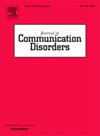Exploring the use of artificial language learning (ALL) paradigms to differentiate intrinsic versus extrinsic sources of language impairment
IF 2.1
3区 医学
Q2 AUDIOLOGY & SPEECH-LANGUAGE PATHOLOGY
引用次数: 0
Abstract
Purpose
The current investigation aimed to explore the potential of Artificial Language Learning (ALL) paradigms to distinguish between poor language abilities due to intrinsic difficulties in language learning as opposed to difficulties stemming from extrinsic factors such as environmental factors.
Method
Using a 2-step population-based screening procedure, 35 children from mid-high SES with presumed developmental language disorders (pDLD) were compared to an unselected sample of 33 children from low SES on measures of accumulated lexical and morphological knowledge and on tasks assessing lexical and morphological learning ability using artificial language learning (ALL) paradigms.
Results
No significant differences between the pDLD and the low-SES groups were found on lexical and morphological knowledge. However, the low-SES group outperformed the pDLD group in both learning an artificial morphological rule and learning new pseudowords.
Conclusions
These findings indicate that children from low SES, as a group, exhibit diminished language performance similar to that of children with pDLD when tested on conventional measures of accumulated linguistic knowledge yet outperform children with (persumed) DLD when assessed on their ability to learn and make use of new linguistic information to extract morphological rules and establish novel lexical representations. The potential of ALL paradigms in this population is discussed.
探索使用人工语言学习(ALL)范式来区分语言障碍的内在和外在来源
目的本研究旨在探索人工语言学习(ALL)范式的潜力,以区分由于语言学习的内在困难而导致的语言能力低下与由外部因素(如环境因素)引起的困难。方法采用基于人群的两步筛查方法,对35名中高经济地位推定为发展性语言障碍(pDLD)的儿童与33名低经济地位推定为发展性语言障碍(pDLD)的儿童进行词汇和形态知识积累测试,并使用人工语言学习范式评估词汇和形态学习能力。结果低社会经济条件组与低社会经济条件组在词汇和形态知识方面无显著差异。然而,低社会地位组在学习人工词形规则和学习新的假词方面的表现优于低社会地位组。这些发现表明,作为一个群体,低社会经济地位儿童在积累语言知识的常规测试中表现出与pDLD儿童相似的语言表现下降,但在学习和利用新语言信息提取词形规则和建立新词汇表征的能力评估中表现优于(假定)DLD儿童。讨论了所有范式在这一群体中的潜力。
本文章由计算机程序翻译,如有差异,请以英文原文为准。
求助全文
约1分钟内获得全文
求助全文
来源期刊

Journal of Communication Disorders
AUDIOLOGY & SPEECH-LANGUAGE PATHOLOGY-REHABILITATION
CiteScore
3.30
自引率
5.90%
发文量
71
审稿时长
>12 weeks
期刊介绍:
The Journal of Communication Disorders publishes original articles on topics related to disorders of speech, language and hearing. Authors are encouraged to submit reports of experimental or descriptive investigations (research articles), review articles, tutorials or discussion papers, or letters to the editor ("short communications"). Please note that we do not accept case studies unless they conform to the principles of single-subject experimental design. Special issues are published periodically on timely and clinically relevant topics.
 求助内容:
求助内容: 应助结果提醒方式:
应助结果提醒方式:


